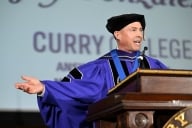You have /5 articles left.
Sign up for a free account or log in.
Few professors would turn down a raise, but even standard contract pay bumps of 3 or 4 percent can leave long-serving faculty feeling less valued than their newer colleagues. That's because junior faculty often are recruited at similar or even higher salaries fresh out of graduate school, especially those in high-demand fields such as business and medicine. The issue, known as salary compression, compounds over time, and it's not great for morale.
But at least one university has stepped outside the box in its approach to equity in professor pay, aiming to bring all faculty salaries up to current market rates for their ranks and discipline, with some getting big percentage raises, and others less. And those involved in contract negotiations at Eastern Washington University say they’d be surprised if other universities didn’t take note.
“All the other schools would be crazy not to do what we did,” said Tony Flinn, professor of English and president of the United Faculty of Eastern, the faculty union affiliated with the American Federation of Teachers and the National Education Association. “Across-the-board pay increases by mathematical definition reward those who already have more and it doesn’t help those at lower income levels.” One-time lump sum salary adjustments, as other universities have made, don't solve the problem long-term, either, he said.
Starting this month, Eastern Washington will divvy up $6.5 million in state funds earmarked for faculty pay among its 436 faculty members, with some getting up to an $18,000 increase annually for each year of the three-year union contract. Most faculty will get at least a 2 percent pay raise annually, and just a handful who already are paid well above the market rate won’t get any increase at all.
Market rate is determined by discipline and rank at peer institutions, based on data collected by the College and University Professional Association for Human Resources.
The plan is the product of long-term planning among the Faculty Organization (the faculty senate equivalent) , the faculty union, and the administration. Samuel Ligon, professor of creative writing and Faculty Organization president, said no faculty member will get unexpectedly rich off of the contract, as it only seeks to bring faculty pay up to the market rate -- something most faculty have been below for years. (Median faculty pay is 10 to 20 percent below the national average for rank and discipline at peer institutions. Full professors are most likely to be paid below market rate.)
But the policy communicates in a very clear way the university’s commitment to longtime faculty, Ligon said – something that he and administrators hope will help reinvigorate the university’s curriculum redesign, and other aspects of university life.
Here’s how the contract reads for the first year:
“[F]aculty with salaries below 90 percent of market (defined herein as 2011-12 [College and University Professional Association] mean) will be brought to the 90 percent level. No market-based increase will exceed $18,000 within a single year. An additional 2 percent (based on the new 90 percent-of-market salary) will be added to the 90 percent-of-market salary. This 2 percent will be referred to as the ‘Year 1 ATB.’ Faculty whose salaries are at or above 90 percent and below 110 percent of market will receive an additional 2 percent of their current salary. Faculty with salaries at more than 110 percent of market but not more than 115 percent of the CUPA mean for their discipline will receive 1 percent of their current salary. Faculty who are currently compensated at more than 115 percent of the CUPA mean for their discipline are not eligible for the across-the-board increases."
In the second year, faculty pay will be brought up to 95 percent of market rate; in the third year, it will be at market rate.
In an e-mail, Eastern Washington President Rodolfo Arévalo said the university “had been concerned about the limited progress that we had made over the past six years to bring faculty salaries up to our peers in the state of Washington and across the country. The added freeze on salaries over the last four years because of the recession only made the salary difference even more dramatic.”
The “only way” to get parity across all ranks and disciplines was to apply a “market variable” to the increase in salaries, he said. “The administration felt that improving faculty quality, and ensuring that those faculty would not leave the university, needed to be the main focus of a new faculty contract.”
Flinn said faculty feedback regarding the plan had been largely positive, but that a few faculty members who would have most benefited from across-the-board pay increases had complained. He said his job this year will be to educate higher-earning faculty on compression issues, pointing out that they’ve been lucky to have been receiving higher pay all along.
“They’ll have to consider themselves rather lucky to not have been underpaid for a long time,” he said.









